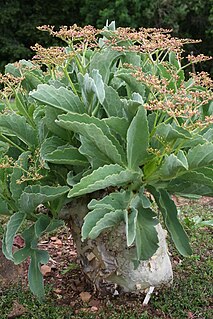| Boscia | |
|---|---|
 | |
| Boscia foetida | |
| Scientific classification | |
| Kingdom: | Plantae |
| Clade: | Angiosperms |
| Clade: | Eudicots |
| Clade: | Rosids |
| Order: | Brassicales |
| Family: | Capparaceae |
| Genus: | Boscia Lam. |

Boscia is a genus of plant in family Capparaceae. It contains the following species:

Plants are mainly multicellular, predominantly photosynthetic eukaryotes of the kingdom Plantae. Historically, plants were treated as one of two kingdoms including all living things that were not animals, and all algae and fungi were treated as plants. However, all current definitions of Plantae exclude the fungi and some algae, as well as the prokaryotes. By one definition, plants form the clade Viridiplantae, a group that includes the flowering plants, conifers and other gymnosperms, ferns and their allies, hornworts, liverworts, mosses and the green algae, but excludes the red and brown algae.

The Capparaceae, commonly known as the caper family, are a family of plants in the order Brassicales. As currently circumscribed, the family contains 33 genera and about 700 species. The largest genera are Capparis, Maerua, Boscia and Cadaba.
- Boscia albitrunca (Burch) Gilg & Ben.
- Boscia angustifolia A. Rich.
- Boscia arabica Pestalozii
- Boscia caffra Sond.
- Boscia coriacea Pax
- Boscia corymbosa Gilg
- Boscia fadeniorum Fici
- Boscia filipes Gilg
- Boscia firma Radlk.
- Boscia foetida Schinz
- Boscia longifolia Hadj-Moust.
- Boscia longipedicellata Gilg.
- Boscia madagascariensis (DC.) Hadj-Moust.
- Boscia microphylla Oliv.
- Boscia minimifolia Chiov.
- Boscia mossambicensis Klotzsch
- Boscia octandra Hochst. ex Radlk.
- Boscia oleoides (Burch. ex DC.) Toelken
- Boscia pestalozziana Glig
- Boscia peuchellii Kuntze
- Boscia plantefolii Hadj-Moust.
- Boscia polyantha sensu Roessler
- Boscia rautanenii Schinz
- Boscia rehmanniana Pestal.
- Boscia reticulata Hochst. ex A. Rich.
- Boscia rotundifolia Pax
- Boscia salicifolia Oliv.
- Boscia senegalensis (Pers.) Lam. ex Poir.
- Boscia tenuifolia A. Chev.
- Boscia tomentella Chiov.
- Boscia tomentosa Toelken
- Boscia transvaalensis Pest.
- Boscia weltwitschii Gilg

Boscia albitrunca, commonly known as the shepherd tree or shepherd's tree, is a protected tree in South Africa. The species epithet "albitrunca" refers to the oftentimes white trunk. Traditionally, the Shepard Tree was used by Dutch settlers, "boers", to create a variant of coffee that is derived from the roots of the tree. It is an evergreen tree native to southern and tropical Africa, living in the hot, dry, and often brackish low-lying areas, sometimes on abundant lime or occasionally found in rocky terrain. It is a common tree of the Kalahari, bushveld and lowveld. It is one of the most important forage trees in the Kalahari.
Boscia arabica is a species of plant in the Capparaceae family. It is found in Oman and Yemen. It is threatened by habitat loss.

Boscia foetida, commonly known as the stink shepherd's tree, is an evergreen shrub or tree that is native to the warmer and drier parts southern Africa. It is found in semi-desert and arid bushveld, and in the west it occurs commonly in areas which are otherwise sparsely wooded. It is known for the particularly unpleasant smell of its flowers which appear during early spring, to which its specific name foetida alludes. Its freshly cut wood likewise has an unpleasant smell, and has traditional medicinal and magical uses, for instance as a protection against lightning.










